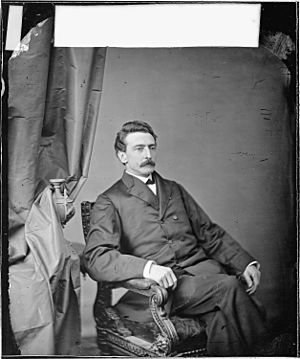Charles E. Phelps facts for kids
Quick facts for kids
Charles Edward Phelps
|
|
|---|---|
 |
|
| Member of the U.S. House of Representatives from Maryland's 3rd congressional district |
|
| In office March 4, 1865 – March 3, 1869 |
|
| Preceded by | Henry Winter Davis |
| Succeeded by | Thomas Swann |
| Member of the Baltimore City Council |
|
| In office 1860–1861 |
|
| Personal details | |
| Born | May 1, 1833 Guilford, Vermont |
| Died | December 27, 1908 (aged 75) Baltimore, Maryland |
| Resting place | Woodlawn Cemetery, Baltimore, Maryland |
| Political party | Know Nothing (1850s) Unconditional Unionist (1861–66) Conservative (1866–69) |
| Spouse | Martha Woodward |
| Parent |
|
| Alma mater | Princeton University Harvard University Law School |
| Military service | |
| Allegiance | Union |
| Branch/service | |
| Years of service | 1861–1864 |
| Rank | |
| Unit | 7th Maryland Infantry Regiment |
| Battles/wars | American Civil War *Battle of Spotsylvania |
| Awards | Medal of Honor |
Charles Edward Phelps (born May 1, 1833 – died December 27, 1908) was an important figure in American history. He was a brave soldier during the Civil War, serving as a colonel in the Union Army. Later, he became a U.S. Congressman for Maryland and even received the Medal of Honor for his courage. After his time in politics, he became a respected judge and a law professor.
Contents
Early Life and Education
Charles Edward Phelps was born in Guilford, Vermont, on May 1, 1833. His father, John Phelps, was a lawyer and a Senator in Vermont. When Charles was five, his family moved to Pennsylvania. At age eight, they moved to Maryland. This was because his mother, Almira Hart Lincoln Phelps, became the head of a school called Patapsco Female Seminary.
Charles went to Princeton University and graduated in 1852. He then studied law at Harvard University Law School, finishing in 1853. By 1855, he was a practicing lawyer in Maryland. He was even allowed to argue cases in the highest court, the Supreme Court of the United States, in 1859. In 1860, he was elected to the Baltimore city council.
Military Service in the Civil War
When the American Civil War began in 1861, Charles Phelps joined the Union Army. He started as a major in the Maryland Guard. In 1862, he became a lieutenant colonel in the 7th Maryland Infantry Regiment. He was promoted to colonel in 1863.
In 1864, during the Battle of the Wilderness, his horse was shot from under him. Later, at the Battle of Spotsylvania, Colonel Phelps was leading his troops when he was wounded and captured. Luckily, he was rescued by General Philip Sheridan's cavalry, led by Brigadier General George Armstrong Custer. For his bravery at the Battle of Spotsylvania on May 8, 1864, Phelps received the Medal of Honor.
He was honorably discharged from the army on September 9, 1864, because of his injuries.
Political Career
Soon after leaving the army, Charles Phelps was elected to the United States House of Representatives for Maryland's 3rd district. He was part of the Unconditional Union Party. He was reelected for a second term as a member of the Conservative Party.
In 1866, President Andrew Johnson nominated Phelps to be a brevet brigadier general of volunteers. The U.S. Senate approved this promotion. A "brevet" rank means he was recognized for his service but did not command troops at that higher rank.
Later Life and Legacy
In 1868, Charles Phelps married Martha Woodward in Baltimore. After his time in Congress, he became a professor of law at the University of Maryland Law School. He also served for many years as a Judge of the Circuit Court of Baltimore.
In 1901, he wrote a book called Falstaff and Equity. This book connected legal ideas to the works of William Shakespeare. In 1907, Princeton University gave him an honorary Doctor of Laws degree, which is a special award for his achievements.
Charles E. Phelps passed away on December 27, 1908, in Baltimore, Maryland. He was buried at Woodlawn Cemetery in Baltimore.

